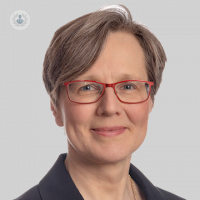Myopia: short-sightedness in children
Written in association with:What is myopia?
People with myopia (short-sightedness) can see things clearly when they are close-up, but things in the distance appear blurred. The commonest reason for myopia is that the eyes have grown a little bit too long. Dr Annegret Dahlmann-Noor, a leading ophthalmologist, explains how myopia is detected, specifically in younger children.

How common is myopia in children?
Short-sightedness is not uncommon in children and usually appears in children from the age of eight years. However, myopia can appear in younger children as well; in fact, it is becoming increasingly common in younger children. Today, around 10 per cent of children are short-sighted by the age of 10 to 12 years, and 25 per cent by the age of 15 to 16 years.
Why do children develop myopia?
There are two major contributors to children becoming short-sighted: genetics and the environment. Myopia runs in families, and if one or both parents are short-sighted, then it is more likely that their children will be short-sighted as well. However, that does not explain why myopia is becoming more and more common in children. The environment plays a big part, too. Children today spend most of their time indoors, both for education and for leisure activities, and many hours each day on screens. Sunlight seems to act as a stop signal to the eyes growing longer, and lack of sunlight in the early years appears to be a risk factor for developing myopia.
What is the best way to reduce the risk of developing myopia?
There is nothing we can do about our genetic background and family history. However, parents should start their children off with good habits and spend some time each day outdoors, particularly in the years before they start school, and during the primary school years. One to two hours a day are ideal. Limiting screen time is not always feasible, but being aware of balancing it with time spent outside is key. At the moment, there are no other treatments to prevent myopia from starting.
What will happen to my child if they have developed myopia?
Usually the myopia gets worse for as long as the child or young person is still growing up, sometimes until they have completed their education. During this time, the prescription for glasses will have gradually higher numbers, which often worries parents and young people. Having a stronger prescription means that we are more dependent on glasses or contact lenses. As a higher degree of myopia usually means that the eye has grown longer than it should, there is also a small risk of complications later in life, such as breaks and detachments of the retina, damage to the optic nerve, and abnormal blood vessels developing under the central retina.
What can be done to stop my child's myopia getting worse?
At the moment, there is no treatment that can stop myopia progression, but there are several new treatments which can slow the worsening down by around 50 per cent. This means that your child will still need a stronger prescription every year, but the final degree of myopia will be less than if they only wear standard glasses or contact lenses. The currently available options are low-concentration atropine eye drops, special contact lenses, and special glasses.
All of these options are currently only available on private prescription or by taking part in clinical trials. The reason is that these treatments have not yet been approved for use in the NHS. For most of them, clinical trials have been carried out in East Asia, where children's myopia progresses very fast, so we know that these treatments work. Clinical trials in the UK, Europe, and the US are still ongoing.
When should my child see an ophthalmologist?
A paediatric ophthalmologist, a specialist in children's eye and vision problems, will carry out a full assessment of the health of the eyes and discuss with you which treatment may be best for your child.
If you would like to schedule a consultation for your child, you can go to Dr Dahlmann-Noor's Top Doctors profile and request a visit.


